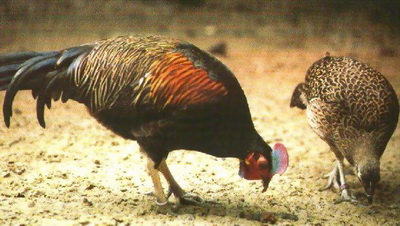|
| Query: phasianidae | Result: 366th of 376 | |
Green Junglefowl (Gallus varius) - Wiki
| Subject: | Green Junglefowl (Gallus varius) - Wiki
| |

| Resolution: 400x226
File Size: 51354 Bytes
Date: 2007:09:16 19:46:50
Upload Date: 2007:09:16 19:50:19
|
Green Junglefowl
From Wikipedia, the free encyclopedia
[Photo] Green Junglefowl (Gallus varius), pair feeding. Photo by Dan Cowell.
The Green Junglefowl, Gallus varius also known as Javan Junglefowl, Forktail or Green Javanese Junglefowl is a medium-sized, up to 75cm long, bird in the pheasants family Phasianidae. It is native to Java, Bali, Lombok and nearby islands in Indonesia.
The coloration of the male Green Junglefowl differs from that of the female. The male is mainly green and black feathered. Its head is topped by a light blue comb, which turns purple or red towards the top. Its wattle is also of the same colour but is bordered with blue on the edges and yellow closer to the throat. The female is mostly brown with occasional green feathers and has no comb.
The Green Junglefowl is being maintained and increasingly bred in captivity as its genetic diversity is disappearing. This is due to the fact that these birds are bred with domestic chickens by many people, producing a hybrid known as the Bekisar. The Bekisar has become very popular in the East Java province and has become the mascot-bird of the area. Therefore the Green Junglefowl requires more protected conditions than chickens. However, it is known to be able to fly more strongly than chickens, and has been seen flying from island to island in its native range, where it lives and breeds along coastal areas.
The Green Junglefowl usually lives in groups of two to five in the wild and led by a dominant male, who takes the flock to feed and drink and then back into the cover of the forest. In the night the flock roosts in bamboo stands at 15-20 feet above the forest floor. In the breeding season the dominant males in each flock are challenged by other males without flocks. The two males would clap their wings and crow loudly while fighting each other with their clawed feet.
The captive Green Junglefowl requires warm aviaries with lots of foliage and cover due to their shy nature and are fed with grains and seeds, as well as fruit and insects as these are the same type of food they would feed on in the wild. This bird has also been known for a long time as a pet animal because of its beauty and unique call.
The Green Junglefowl is evaluated as Least Concern on the IUCN Red List of Threatened Species.
http://en.wikipedia.org/wiki/Green_Junglefowl
| The text in this page is based on the copyrighted Wikipedia article shown in above URL. It is used under the GNU Free Documentation License. You may redistribute it, verbatim or modified, providing that you comply with the terms of the GFDL. |
|
Comments |
|---|
| | Guest |
|
Scientific Name: Gallus varius (Shaw, 1798)
Common Names: Green Junglefowl, Javan Junglefowl, Green Javanese Junglefowl
French: Coq de Java German: Gabelschwanzhuhn Spanish: Gallo de Java
Taxonomy: Phasianus varius Shaw, 1798, Java.
Synonyms: Creagrius varius |
^o^
Animal Pictures Archive for smart phones
^o^
|
|
|

